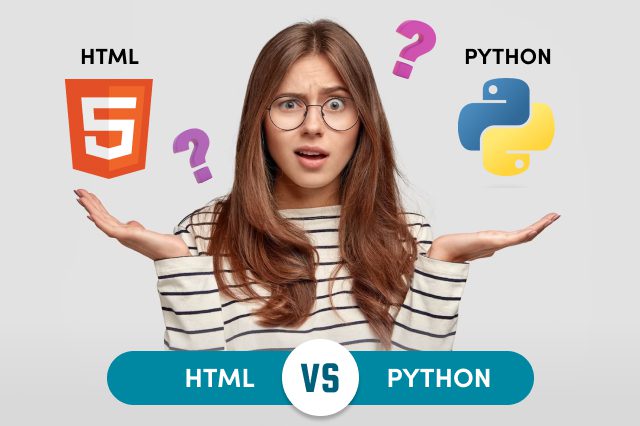Businesses worldwide are effectively looking to upgrade their websites for assured performance. Now, when looking for website development, the first and foremost thing to consider is selecting the appropriate programming language. In any website development, it is the language that holds the potential and success of the entire project. Among several options, two definite choices that steadily stand out include Python vs. HTML as the best option. Each language brings unique strengths and limitations when developing a website. In this blog, we will rightly analyze the importance of both and determine the best between Python and HTML for web development.
Python for Front-End Web Development
Python is widely popular and renowned for its versatility and simplicity in front-end web development. Although, it might not be the first-ever language that comes to mind when front-end web development is considered. However, this language’s exceptional features have made it stand out effectively. It also has many libraries that streamline the entire web development process. Utilizing these libraries of Python from a professional web development company also helps to minimize excessive coding lines. A proper transition from back-end to front-end development also helps to foster better collaboration among developers.
Although renowned for its readability and user-friendly syntax, Python is one of the most versatile programming languages that has gradually found its place in front-end development despite not being traditionally associated with it.
Frameworks for Web Development:
Python boasts several robust web frameworks like Django, Flask, and Pyramid. These frameworks expedite and simplify development by providing pre-built tools for completing tasks. These tasks usually include database interaction, routing, and templates. These facilitate a seamless integration for both front and back-end components.
Rapid Development:
Python’s clean and human-readable syntax makes development cycles effectively accelerated. This definite benefit is particularly advantageous during prototyping and iterative design phases. CMS web developers can swiftly articulate their ideas through this by translating to shorter development timelines.
Data Manipulation:
Python’s robust data processing capabilities have readily extended to the front-end domain. If you have a significant need for an application with real-time data manipulation, then Python might be the best framework for its usage. Python’s dynamic and interactive user interface empowers the creation of interactive user interfaces and responsive user actions.
Machine Learning Integration:
Python effective libraries might be the best solution for projects requiring machine learning or data analysis. Effective libraries of Python, like TensorFlow, sci-kit-learn, and NumPy, can seamlessly merge with the front-end interface. This also enables integration with advanced functionalities, including recommendation systems and predictive analytics.
Furthermore, Python’s strong object-oriented programming (OOP) foundation can encourage code reusability and modular design. This, in turn, can enhance the maintainability of front-end codebases when developed by a web development company. Additionally, the availability of pre-built templates and components can expedite the creation of visually appealing interfaces.
HTML For Front-End Web Development
Hypertext Markup Language, on the other hand, has been a definite selected language for web development ever since its inception. It serves as the foundational structure for presenting content on the internet. HTML’s simplicity lies in its tag-based approach, where different elements define the form of a web page. This HTML feature makes it intuitive and simple to implement from a selected CMS web design company.
HTML, the cornerstone of web development, is a markup language for structuring web page content. While HTML is not a programming language like Python, it forms the bedrock for constructing web interface layouts and content.
Structure and Content:
HTML’s primary role is defining web page structure and content. A hierarchical system of elements arranges content like headings, paragraphs, lists, images, and links. This structured approach ensures that content is presented in a definite, coherent, and legible manner.
Responsive Design:
HTML stands at the core of responsive web design in collaboration with CSS (Cascading Style Sheets) and JavaScript. It empowers every developer to craft interfaces adaptable to diverse screen sizes, ensuring consistency across platforms.
Semantics:
Incorporating semantic-based elements with HTML tends to convey a different meaning for the selective web pages. It utilized the use of tags like header and footer to help users browse through the website pages. Using these tags gives easy accessibility for search engines to find the right words and crawl faster. This enhances both search engine optimization and visibility of the website pages.
Cross-Browser Compatibility:
HTML, as a standardized language, garners support from all major web browsers. This universal acceptance guarantees that web pages constructed with HTML render uniformly across different browsers, mitigating compatibility challenges.
Python and HTML: Bridging the Gap
To truly weigh the strengths and limitations of Python and HTML for front-end web development, it’s crucial to consider where they converge. Python can be used in conjunction with HTML to enhance the frontend experience. Utilizing frameworks like Brython, developers of CMS website design companies can write Python code directly within HTML documents. This also enables better and more dynamic content generation. This symbiotic relationship enables us to capitalize on the simplicity of HTML while leveraging Python’s scripting capabilities for web development CMS.
Python Vs. HTML: A Synergistic Approach:
The synergy between Python and HTML facilitates Python’s adaptability with HTML’s fundamental strength, culminating in web applications. This definite cooperative approach uniquely analyses the importance of leveraging each language’s attributes to create a holistic web development experience.
Transitioning Between Python and HTML:
Modern web development is characterized by its inherent flexibility. Developers often find themselves transitioning between Python and HTML based on the users’ needs. The seamless integration of both languages ensures that tasks are completed in a streamlined manner without compromising the end-user experience. This adaptability underscores the importance of Python Vs. HTML in the transition by leveraging strengths and weaknesses.
Python vs. HTML: Which One to Choose?
In the dynamic arena of frontend web development, the choice between Python and HTML comes to the choice project needs. Python, with its versatile libraries and tools, can be a powerful ally in creating engaging user interfaces. However, HTML remains the quintessential foundation upon which the web is built, offering simplicity and reliability.
The ultimate decision at the end depends on the right balance between the two definite languages. When facilitating usage, developers of a selected CMS website design company can use Python for scripting and rely on HTML for better structure. Proficiency in both languages can offer multiple benefits when rightly applied to a project.
Conclusion
In navigating the ever-evolving expanse of front-end web development, the decision to employ Python Vs. HTML is not a choice but a strategy. Python’s versatility and HTML’s foundational role contribute significantly to creating exceptional web applications. Therefore, whether harnessing Python for dynamic content or HTML for page design, selecting the best web development company is essential. The main value lies in analyzing and utilizing the strengths and weaknesses of these languages.






















![Bard vs. ChatGPT: What’s the difference? [2024] Google Bard AI](https://mygentec.com/wp-content/uploads/2024/04/google-bard-ai-218x150.jpg)






![Bard vs. ChatGPT: What’s the difference? [2024] Google Bard AI](https://mygentec.com/wp-content/uploads/2024/04/google-bard-ai-100x70.jpg)


